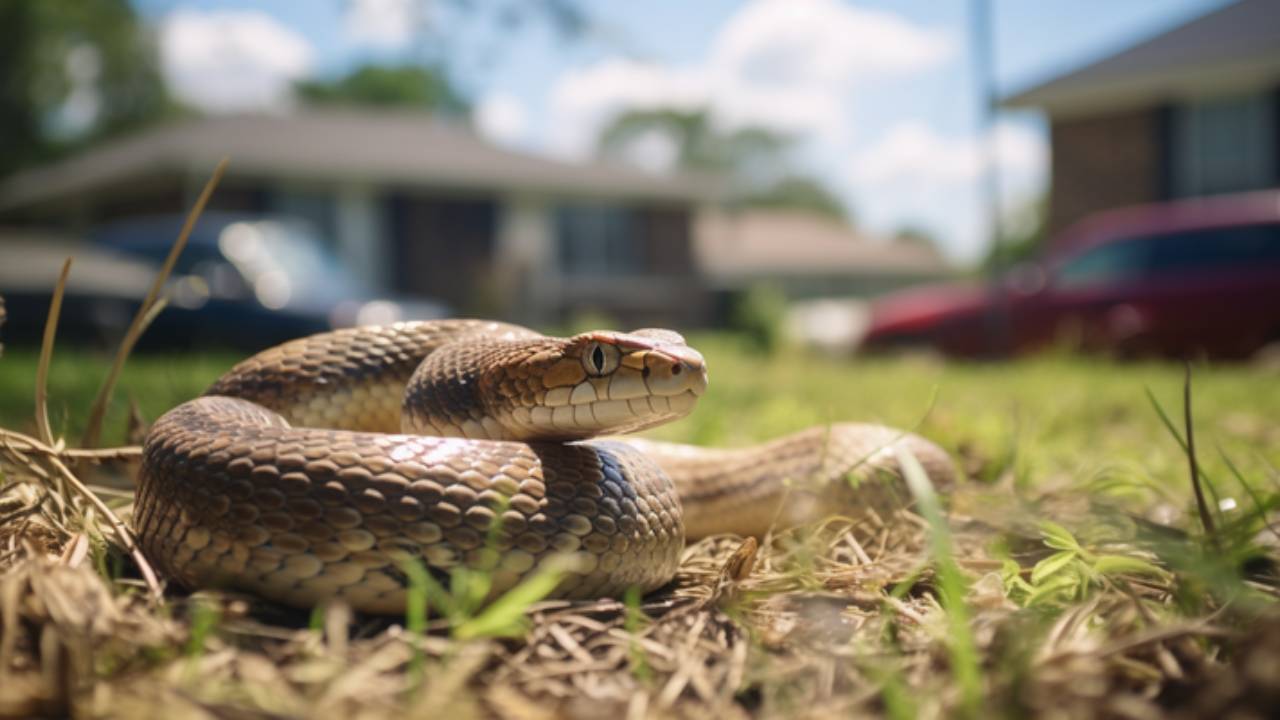Imagine a sunny afternoon at the dog park. Your beloved puppy is frolicking with newfound furry friends, tails wagging in pure delight. Everything seems perfect until an unexpected danger slithers into the scene – a venomous snake.
While we’d all like to think our pups are invincible, it`s not. Snakebites in dogs are more common than we’d like to believe. We will arm you with the essential knowledge to protect your pet so you have peace of mind in the wilds of your backyard or on the trail.
The Venomous Culprits
Before diving into the details of snakebites in dogs, it’s essential to understand the potential assailants. Venomous snakes vary by region, so being aware of the local venomous species is crucial. Some venomous snakes to watch out for in the United States include rattlesnakes, copperheads, cottonmouths (also known as water moccasins), and coral snakes.
Rattlesnakes are the most well-known venomous snakes in North America. Recognizable by their rattling tails, they’re found in various regions.
Copperheads: Common in the eastern and central United States, copperheads sport a coppery-colored head and hourglass-shaped body bands.
Cottonmouths (Water Moccasins): Predominantly residing in the southeastern U.S., cottonmouths are often found near water bodies.
Coral Snakes: Coral snakes are colorful and venomous, featuring bands of red, yellow, and black. They’re primarily found in the southern states, including Florida and Texas.
Signs of a Snakebite
Understanding snakebite signs in dogs is crucial for prompt action. If your dog is bitten, you may notice some or all of the following symptoms:
- Puncture Wound
- Swelling
- Pain and Discomfort
- Bleeding
- Bruising
- Difficulty Breathing
- Weakness and Lethargy
- Dilated Pupils
When you notice these signs or suspect a snakebite, rush your dog to the nearest veterinary clinic or emergency animal hospital.
Time is of the essence when it comes to snakebites because the severity of the reaction can vary depending on the type of snake and the amount of venom injected.
Your veterinarian will assess the bite, administer necessary treatment, and may recommend additional tests to gauge the extent of the envenomation. If you saw the snake, provide information about its color, size, and any markings. This information will help the vet determine the appropriate treatment. Investing in dog insurance can alleviate the financial burden of unexpected emergencies, such as snake bites.
Treatment for Snakebites
Treating a dog for a snakebite involves prompt and calm action. Immediately locate the bite site, typically indicated by two puncture wounds, and keep your dog still to slow venom spread. Transport your dog to a veterinarian or emergency animal hospital quickly, avoiding home remedies like suction, ice, or tourniquets, as these can worsen the situation. On the way, monitor your pet’s breathing, heart rate, and behavior, providing this crucial information to the medical team upon arrival.
The vet will then assess the bite’s severity and administer appropriate treatments such as antivenom, pain relief, and supportive care. Follow-up care is critical to address potential complications, following the veterinarian’s guidance for home care and any subsequent check-ups.
Quick, informed action is key to managing snakebites effectively.
Coral Snakebites: A Deadly Exception
Coral snakes are a unique case among venomous snakes in the United States. Their venom is highly potent, but they have smaller fangs and are less likely to deliver a substantial amount of venom in a single bite. However, this makes them more dangerous.
Coral snakebites may not exhibit immediate symptoms, making them even more challenging to detect. For several hours, dogs bitten by coral snakes might not show signs of envenomation. Therefore, it’s crucial to treat all coral snakebites as emergencies.

Risk Factors for Snakebites in Dogs
Understanding the risk factors for snakebites in dogs can guide you in taking effective precautions. Here’s an enhanced overview of these factors:
1. Geographical Risk: Dogs in regions with a high population of venomous snakes naturally face greater danger. Knowing the local snake species and their habitats is crucial for assessing risk levels.
2. Exploratory Behavior: Adventurous dogs, particularly those that roam freely in natural settings, are more prone to snake encounters. Monitoring their outdoor activities and maintaining control in snake-prone areas can mitigate risks.
3. Optimal Snake Activity Times: Snakes often exhibit increased activity during early mornings and late afternoons. Adjusting your dog’s outdoor schedule to avoid these peak times can reduce the likelihood of encounters.
4. Seasonal Awareness: Snakes are more active in warmer seasons, with spring and summer posing higher risks. Heightened vigilance during these periods is essential for prevention.
5. Habitat Hazards: Areas with dense underbrush, rocks, or fallen logs are prime habitats for snakes. Keeping dogs on trails and clear paths can minimize the chance of unexpected snake interactions.
Tip: Investing in snake aversion training teaches dogs to recognize and avoid snakes, significantly reducing the risk of bites. This training can be a lifesaver, especially in high-risk areas.
Prevention of Snakebites
Preventing snakebites in dogs involves a combination of awareness, training, and environmental management. Here are some proactive steps to consider:
- Leash Your Dog: When in snake-prone areas, keep your dog on a leash to maintain control and prevent them from investigating potential dangers.
- Avoid High-Risk Areas: If you know local snake habitats, avoid these areas during walks or hikes.
- Stay on Paths: Stick to well-traveled paths and avoid letting your dog explore tall grass or dense underbrush.
- Snake Aversion Training: Consider enrolling your dog in snake aversion training classes. These classes teach dogs to recognize and avoid snakes by scent and sound.
- Yard Maintenance: Keep your yard well-maintained, as snakes are less likely to linger in well-groomed areas. Remove debris, woodpiles, and other potential snake hiding spots.
- Repellents: Some snake repellents can be applied to the perimeter of your property to deter snakes from entering. Consult with a professional before using any chemical repellents.
- Vaccination: Ask your veterinarian about snakebite vaccinations, which can provide some protection against certain types of snake venom.
To summarize, dog snake bites are frightening experiences that can happen when you least expect them. Being informed and prepared is key to protecting your furry friend. Remember the signs of a snakebite, seek immediate veterinary care, and consider preventive measures such as leash control, avoiding high-risk areas, and even snake aversion training.

FAQs
How can I tell if my dog is allergic to a snake bite?
An allergic reaction may manifest as hives, swelling in areas other than the bite site (like the face), difficulty breathing, or collapse. Immediate veterinary attention is crucial to manage these symptoms.
What first aid supplies should I have if a snake bites my dog?
Your first aid kit should include gauze to wrap the wound, saline solution to clean it, a muzzle to protect yourself from bites, and emergency contact numbers for your vet and the nearest animal hospital.
Can snake bites affect my dog’s long-term health?
Venomous snake bites can lead to long-term health issues such as tissue damage, infection, and, in severe cases, organ damage. Monitoring and follow-up care with your vet are essential to manage potential complications.
How do I safely transport my dog to the vet after a snake bite?
Keep your dog calm and still to slow the spread of venom. Carry your dog rather than allowing it to walk, and if possible, place it in a crate or on a stretcher for transport.
Are certain dog breeds more susceptible to snake bites or their effects?
While no specific breed is more susceptible to being bitten, smaller dogs and those with shorter noses may experience more severe effects due to their smaller body size and closer proximity to the ground.
What measures can I take to reduce the likelihood of my dog encountering a snake?
Keep your yard clean and free of rodent attractants, use snake repellents, supervise your dog in wooded or grassy areas, and train your dog to come when called to avoid potential encounters with snakes.
While we can’t eliminate all risks, we can certainly reduce them, ensuring that our puppies and dogs can continue to enjoy their adventures in a safer, snake-aware world.
References
- What to Do if Your Pet is Bitten by a Snake. Detailed information on snake bite responses and treatment for pets is available at today.tamu.edu.
- Clinical Features and Management of Snake Bites in 70 Dogs in Korea – Understand regional specifics and treatment outcomes. Read more at PubMed.
- Retrospective Evaluation of Snake Envenomation in Dogs (2004 to 2021): Discover findings from extensive case studies. The detailed research is available in PubMed.
- UTCVM Veterinary Medical Center Snakebite Study. This is In-depth research on snakebite incidents and veterinary care. More information is available at vetmed.tennessee.edu.






snakes are dangerous, whether you are a human or an animal